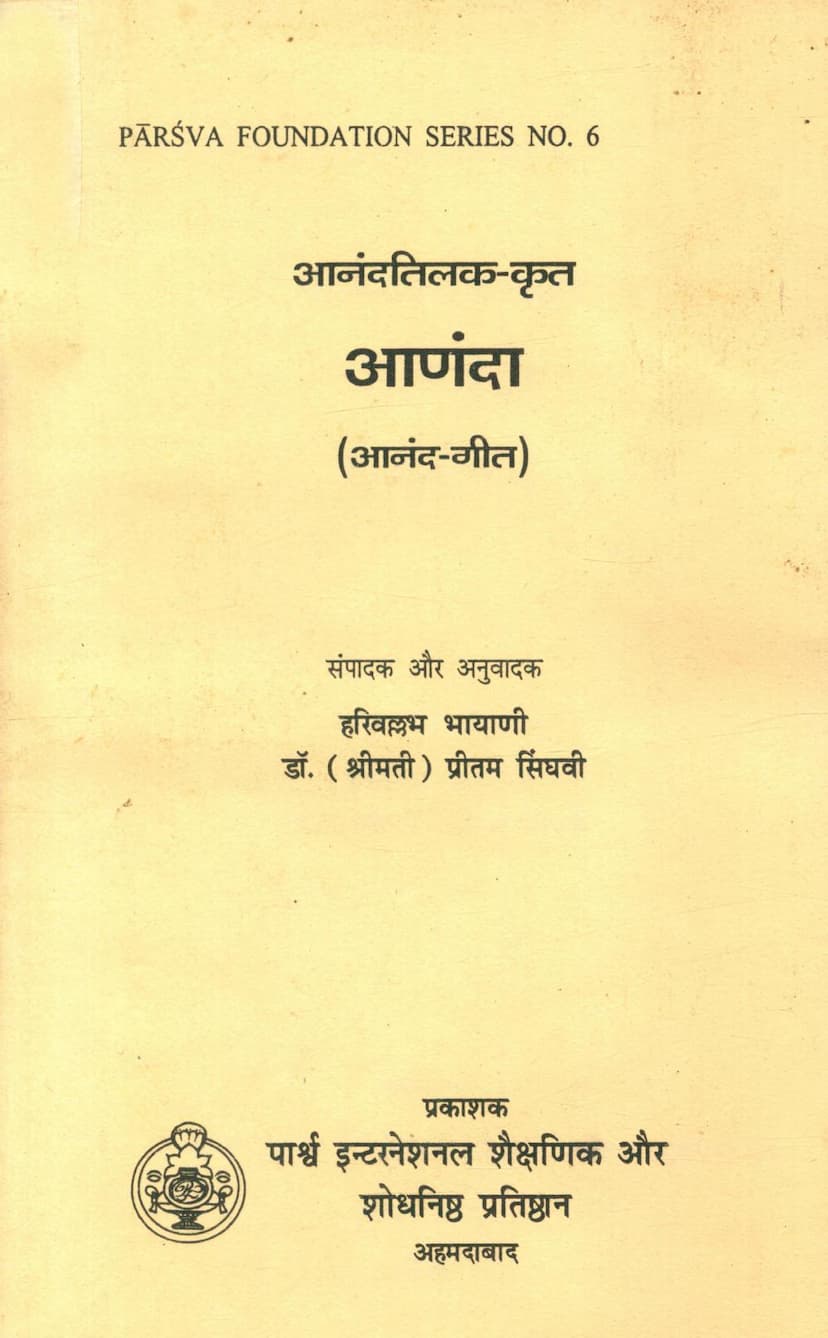Ananda
Added to library: September 1, 2025

Summary
Here's a comprehensive summary of the Jain text "Āṇandā" (Ānanda-gīt) by Ānandatilaka, based on the provided text:
Title: Āṇandā (Ānanda-gīt) - The Ānanda-song Author: Ānandatilaka Editors and Translators: H. C. Bhayani, Dr. (Mrs.) Pritam Singhvi Publisher: Pārśva International Educational and Research Foundation, Ahmedabad Publication Year: 1999 Language of Original Text: Late Apabhraṁśa Genre: Jain spiritual-didactic lyrical poem
Overall Summary:
"Āṇandā" is a significant lyrical poem in Late Apabhraṁśa, attributed to the Jain spiritual-didactic tradition. Composed of 43 verses (dohas), the work is a profound exposition of Jain spiritual philosophy, primarily focusing on the nature of the soul, its inherent bliss, and the path to liberation. The poem strongly emphasizes inner spiritual practice over external ritualistic observances, highlighting the importance of self-realization, the guidance of a true guru, and the attainment of equanimity (samādhi) as the ultimate means to overcome suffering and achieve salvation.
Key Themes and Content:
- The Nature of the Soul: The poem asserts that the soul (Ātmā) is inherently pure, blissful (ānanda), stainless (niranjana), and the ultimate reality (Śiva). It is distinct from the physical body and its attributes.
- Rejection of External Rituals: A central theme is the critique and dismissal of superficial external practices. This includes:
- Idol Worship and Superstition: The text denounces the worship of false deities (kudeu) and inanimate idols (pāṣāṇa), deeming it futile and misleading.
- Pilgrimages and Asceticism: Traveling to 68 holy places (aṭhasasṭhi tīrtha) or engaging in mere outward signs of asceticism like matted hair (jaṭādhāraṇa) or hair plucking (keśa locana) are considered meaningless without inner realization.
- Empty Observances: Fasting, abstaining from certain foods, and rigid adherence to rituals without understanding the true essence of spiritual discipline are rejected.
- Emphasis on Inner Purification and Knowledge: The poem champions the following as the true path:
- Meditation (Dhyāna): Meditation is described as a lake of nectar (amṛta jala) where the wise cleanse the "mud" of eight karmas, leading them closer to liberation. The fire of meditation is potent enough to burn away karmic impurities.
- Self-Knowledge and Realization: The ultimate goal is to know and experience the self (Ātmā). This self-knowledge is the true conduct (vivahāra) and the essence of Jainism.
- Equanimity and Inner Peace (Sahaja Samādhi): Attaining a state of natural equanimity and inner stillness is crucial. This is the essence of the Jain path.
- Guru's Guidance: The importance of a Sadguru (true spiritual teacher) is repeatedly stressed. A guru provides the knowledge to distinguish the soul from the non-soul, guides towards self-realization, and is the key to overcoming ignorance. The guru is equated with the Jinavara (Jina) and the Siddha (liberated soul).
- Renunciation of Ego: The poem advocates for shedding ego (nirahaṁkāru) to achieve true spiritual progress.
- Spiritual Realization as Liberation: True liberation (mokṣa, śivapurī) is achieved through the knowledge and experience of the soul. It is not bestowed by external deities like Hari, Hara, or Brahma, nor by the Jinavaras themselves, but must be attained by the individual soul through its own efforts guided by the guru.
- The Divine within: The poem suggests that the divine, the blissful being (cidananda), resides within one's own body. The task is to recognize and worship this inner deity.
- Metaphorical Language: The text uses rich metaphors, such as the meditation lake, the fire of meditation, and the pervasive essence of fire in wood or fragrance in a flower, to illustrate spiritual concepts.
Editorial and Scholarly Aspects:
- Editing and Translation: The work has been meticulously edited and translated by H. C. Bhayani and Dr. Pritam Singhvi, making it accessible to a wider audience.
- Manuscript Basis: The editing is based on multiple manuscripts, including one from Dr. Devendra Kumar Shastri and another from the late Agarchand Nahata, acknowledging variations and textual issues.
- Language and Dating: The language is identified as Late Apabhraṁśa, with minimal regional influence, suggesting a composition date around the late 13th century CE or later. The influence of earlier works like Muni Ramasinha's "Doha Pāhuḍ" is noted.
- Attribution: The authorship is attributed to Ānandatilaka, who possibly also used the name Mahānandi in some contexts (referring to his guru or his own spiritual state). The poem itself mentions the author's name through a wordplay.
- Scholarly Apparatus: The publication includes a preface, a guide to the meaning of the verses, the original Apabhraṁśa text with its Hindi translation, annotations, and an index of verses.
Significance:
"Āṇandā" serves as a valuable testament to the continuity of the mystical and introspective traditions within Jainism. It offers a clear and direct message, guiding practitioners away from mere ritualism towards the profound path of self-realization, underscoring the transformative power of inner spiritual discipline and the indispensable role of the guru.